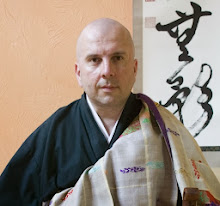Kesa, Okesa
I would like to express my gratitude to have met with all my heart this tradition and style. In Japanese, it is called Nyoho-e, the robe-garment of as it-is-ness. Thanks to the work and life of the Shingon teacher Kaiju Jiun Sonja (1718-1804) who loved being grasped by the still state, to the dedication of Mokishutsu Zenji and later, to Eko Hashimoto and Kodo Sawaki, we have now the opportunity to study, sew and wear the Buddhist robe.
Originally, it is said that one day the Buddha was peacefully walking in the country with Ananda. All around them were valleys and fields, clouds and sky, air and mists, and birds, and beasts. Ananda asked the Buddha : “ we need a special garment that will show to the rest of the world that we are your disciples”. With a wave of his hand, Buddha indicated nature all around them and said : “Our garment will be like this”. Buddha was just pointing to the paddy fields, so Ananda thought that he meant the paddy fields, the rice fields. Buddha was just pointing to the whole universe, formless, ever changing. Ananda understood the paddy fields. Shakyamuni Buddha had a complete free mind, an open mind. He could embrace the whole view with a single glance, he did not choose, did not fix any boundaries, a consciousness without a single choice, no judgement, just the recognition of things as they are.
The kesa is a patchwork made of small or medium patches sown together (it is not always the case though, some kesas are made of a big piece of material folded in order to create the pattern of horizontal and vertical stripes and lines). Its surface is made of vertical stripes that are themselves divided horizontally. The number of stripes is always impair and can vary from 5 to 25, with all the possible variations in between. Each stripe has a short patch and two or more longer patches. The whole body of the kesa is surrounded by a border and four squares of similar size (kakusho or shiten) ornate the four corners. Most of the time, the kesa has a rectangular shape. Its size can vary accordingly to the person wearing it (the measurements of the kesa has to be established accordingly to the proportions of the body) and to its nature: the small kesa called rakusu is used for samu, travelling and other activities, the big kesa of seven stripes is used for Zazen and the nine, eleven, thirteen, fifteen, seventeen, nineteen, twenty-one, twenty-three or twenty-five stripes are used for ceremonies or more formal occasions.
Why does a bloke like me have spent so much time studying this, sewing this, doing this? I don’t know. I can’t tell. My understanding of zen is very very shallow and as far as I remember, I have always sown kesa after kesa, rakusu after rakusu, giving them away. Sometimes keeping them, protecting them, wearing them.
.
What is it? It is the robe of IT. It is the robe of the ineffable, the robe of Tatagatha. You wear it when you sit. In my shallow understanding, a monk has to shave his hair, wear the kesa and sit. Nothing else is required. No proper posture is required but allowing the right direction to become true in one’s life.
In a few months’ time, I will be walking slowly the streets of Kyoto singing, carrying the begging bowl and wearing the kesa.
Later, I shall enjoy the water of an onsen, naked and happy. Still wearing the kesa. All things always surround me. I owe my life to tatagatha’s compassion. Naked or dressed, this is the kesa.
Whatever I do, wherever I go, this place never leaves me. Kesa. Simplicity. Black-Brown-Grey-dirty-dye.
Whoever you are and wherever you go, please, let me know if you are interested in sewing-wearing and protecting Tatagatha’s robe. When I am in Japan, I will spend some time to study the nyoho-e kesa but also other kesa of different schools. Eventually, I would like to create a website that would make teachings about the kesa available to everyone.
You’ll always find me not too far from the blue mountain.


3 Comments:
Bowing to you,
Floating weed,
beyond this noise of mine and sometiems anger
beyond difference and unity
lies the field
I vow to let my life goes to this, live in this, die in this
rain, evrywhere indeed.
Love
Pierre
Pierre,
I would like to make a kesa, but aside from some general descriptions, I cannot find instruction. Do you have any advice or suggestions that may help?
Good for you, nickm. Good for you. Bravo!!
Post a Comment
<< Home